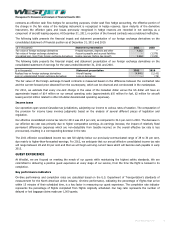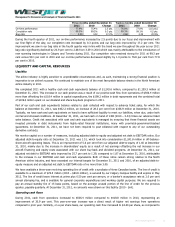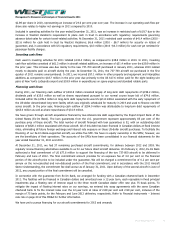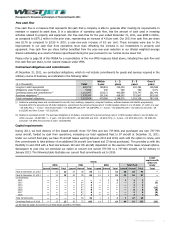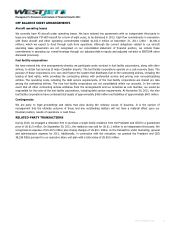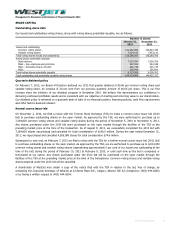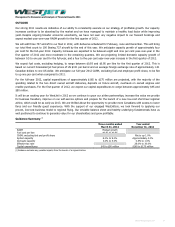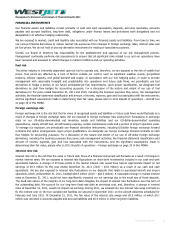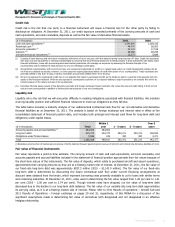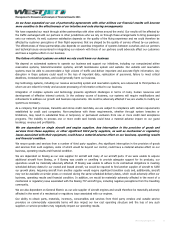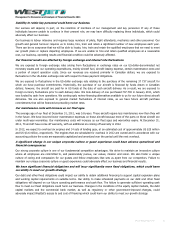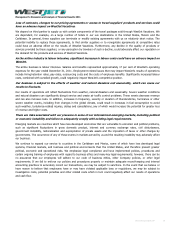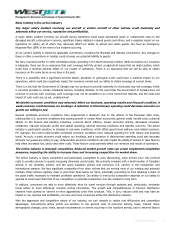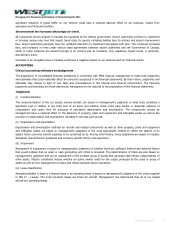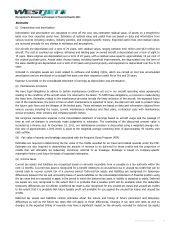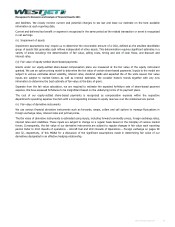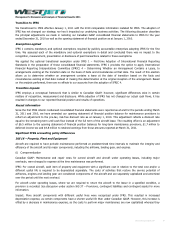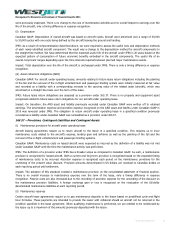Westjet 2011 Annual Report Download - page 42
Download and view the complete annual report
Please find page 42 of the 2011 Westjet annual report below. You can navigate through the pages in the report by either clicking on the pages listed below, or by using the keyword search tool below to find specific information within the annual report.
Management’s Discussion and Analysis of Financial Results 2011
│
RISKS AND UNCERTAINTIES
The risks described below are not intended to be an exhaustive list of all risks facing the Company. Other risks of which we
are not currently aware or which we currently deem immaterial may surface and have a material adverse impact on our
business. Management performs a risk assessment on a continual basis to ensure that significant risks related to our airline
have been reviewed and assessed.
Risks relating to the business
We are dependent on the price and availability of jet fuel. Continued periods of high fuel costs, volatility of fuel
prices and/or significant disruptions in the supply of fuel could adversely affect our results of operations.
Fuel price volatility continues to represent a significant risk, as the cost of fuel has seen historically elevated levels throughout
the past few years and is largely unpredictable. Fuel prices are affected by a host of factors outside our control, such as
significant weather events, geopolitical tensions, refinery capacity and global demand and supply. A small change in the price
of fuel can significantly affect profitability. Our ability to react to fuel price volatility may be delayed and affected by factors
outside our control and by factors such as our low-cost high value philosophy, the portion of our customer segment that
travels on a discretionary basis for leisure, and the demand impact resulting from fare increases.
Our fuel costs constitute our largest single expense category, representing approximately 33 per cent of operating costs in
2011 and approximately 28 per cent in 2010. Our low cost structure has been one of our core strategic advantages and
facilitates our ability to offer our customers lower fares, which in turn allows us to increase market share and yield, and impact
our growth strategy. Therefore, the price of fuel has affected, and could continue to affect, the timing and nature of our
growth initiatives, and our ability to hedge our fuel costs on a cost-effective basis may be limited and the effects of accounting
for hedges could adversely affect our financial results.
In the event of a fuel supply shortage or significantly higher fuel prices, a curtailment of scheduled service could result. A
significant increase in the price of aircraft fuel could result in a disproportionately higher increase in our average total costs in
comparison to those of our competitors, if their hedging programs are more effective in mitigating the risk of the increasing
costs of jet fuel.
Failure to achieve our growth strategy could have a material adverse effect on our financial condition and
results of operations.
Our growth strategy involves increasing the number of markets served and increasing the frequency of flights to the markets
we already serve. During the initial phases of implementing service in a new market, we are more vulnerable to the effects of
fare discounting in that market by competitors already operating in that market or by new entrants. There can be no
assurance that we will be able to identify and successfully establish new markets.
Our plan to launch a new short-haul regional airline could result in unforeseen disruptions, distractions and
costs.
From our beginning, we have operated using a single aircraft type, the Boeing 737, and through our extensive experience in
operating and maintaining that single aircraft type we have developed systems and procedures to mitigate operating and
financial risks. To effectively launch and integrate a new short-haul regional airline into our current operations, we must
establish appropriate operational, administrative, finance, management systems and controls and marketing functions relating
to such an airline, which could result in the occurrence of unforeseen costs that may adversely affect our profitability.
This initiative will also require substantial attention from our management team. This diversion of management attention, as
well as any other difficulties which we may encounter in undertaking the process of developing and integrating a new short-
haul regional airline with our existing business could have an adverse impact on our business, financial condition, results of
operations and cash flows. We may not realize on one or more of the goals we have established for the new short-haul airline
which could affect the profitability of the new airline.
WestJet Annual Report 2011 42



